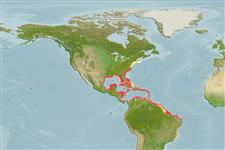Preferred temperature (Ref.
115969): 23.3 - 28, mean 26.4 (based on 412 cells).
Phylogenetic diversity index (Ref.
82804): PD
50 = 0.5000 [Uniqueness, from 0.5 = low to 2.0 = high].
Bayesian length-weight: a=0.01479 (0.01312 - 0.01668), b=2.97 (2.95 - 2.99), in cm Total Length, based on LWR estimates for this species (Ref.
93245).
Trophic level (Ref.
69278): 4.3 ±0.4 se; based on diet studies.
Resilience (Ref.
120179): Low, minimum population doubling time 4.5 - 14 years (Preliminary K or Fecundity.).
Prior r = 0.60, 95% CL = 0.39 - 0.89, Based on 1 data-limited stock assessment.
Fishing Vulnerability (Ref.
59153): High vulnerability (62 of 100).
